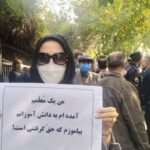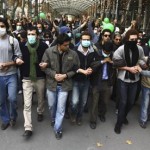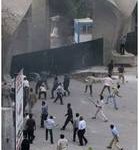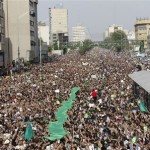
Last Friday, November 20, Channel 13 reported that Israel and the US were planning to increase pressure on Iran with “covert operations” and economic sanctions during Trump’s final weeks in office. The next day, the United States rapidly deployed several heavy bombers to the Middle East in a threat to Iran, amidst swirling speculation that US President Donald Trump plans to “go out with a bang” and take military action against Tehran before President-elect Joe Biden enters office.
The US Central Command said the planes were sent into the region “to deter aggression and reassure US partners and allies.” In a highly irregular move, the B-52H Stratofortress planes were seen flying toward Israeli airspace on Saturday, November 21, en route to the base where they will be stationed, likely in Qatar. The aircraft were spotted on civilian tracking software approaching Israel before they apparently turned off their transponders, rendering them invisible on those applications.
It was the third time in the past year and a half that B-52 bombers, which are capable of carrying nuclear weapons and other powerful munitions, have been deployed to the region in tacit threats to Iran. In previous cases, the bombers were not detected flying through Israeli airspace. It was not immediately clear what accounted for the change in route, if there was one. The planes were ordered on short notice to fly to the Middle East nonstop from their home base in North Dakota, refueling along the way in mid-air. The bombers were accompanied on the mission by F-15 and F-16 fighter jets, as well as KC-10 and KC-135 refueling planes, US Central Command (CENTCOM) said.
US Secretary of State Mike Pompeo visited the region over the past week, including a stop in Israel, in which he told the Jerusalem Post that the US would consider a military strike against Iran. “The administration has been clear on that for its entire four years. There is no reason that would change today or tomorrow,” Pompeo said.
Last week, the media reported that Trump had asked top advisers if he had options to strike Iranian nuclear sites during his last weeks in office, but was dissuaded with warnings such an act could lead to a wider conflict. Exactly. Following publication of Trump’s consultation with advisers, Iran, for its part, threatened a “crushing” response to any US military strike on the country’s nuclear facilities. “We have said it before, and repeat it now, that any action against Iranian people will face a crushing response,” Ali Rabiei, Iran’s government spokesman, told journalists on Tuesday, November 17.
Fine-Tuning the Anti-Iranian Axis towards War
On Sunday, November 22, in the first visit of its kind, Prime Minister Benjamin Netanyahu traveled to Saudi Arabia, where he met with Crown Prince Mohammad bin Salman and US Secretary of State Mike Pompeo, Israeli and Saudi officials said Monday. Netanyahu was on the ground in Neom, a planned city in the Tabuk Province of northwestern Saudi Arabia near the Red Sea, for more than three hours. This was the first known high-level meeting between an Israeli and Saudi leader. He was accompanied by Mossad intelligence Chief Yossi Cohen, Israeli media reports said. Netanyahu and Cohen traveled to Saudi Arabia on the private plane of prominent Israeli entrepreneur Ehud Angel — the same jet that the prime minister used for a covert visit to Oman last year. In light of the plethora of visits by Netanyahu without any of his ministers to three Arab Gulf states in a number of months, and the “normalization” of relations between Israel and the UAE, Bahrain, and Sudan, presented by the PM to the Israeli public as “peace for peace,” but all part of Trump’s “Deal of the Century” and his unsuccessful electoral campaign for reelection, the PM’s visit to Saudi Arabia the day after the deployment of heavy US bombers to the region bodes ominously for what is very likely about to take place. The timing is clearly determined by Trump’s imminent end of occupancy in the White House. With only 55 days before he is due to leave office, barring a successful attempt to overturn the results of the US presidential elections (via the electoral college vote; the House of Representatives; or the US Supreme Court – all possible under the American Constitution), a strategy Trump remains unabashedly intent on achieving, the coming days and weeks are the last chance for the ostensibly lame duck president to strike Iran, something which he’s repeatedly and passionately been encouraged to do by Benjamin Netanyahu since the beginning of his administration.
Hadash lawmakers on Monday severely condemned the Prime Minister’s trip to Saudi Arabia, alleging that it could spark a regional war in the final days of the Trump administration. “Netanyahu and his partners in the outgoing Trump administration, along with the leaders of Gulf states, understand they’re living on borrowed time and are trying to take advantage of the months that are left until Trump leaves to stir up a war,” said Joint List MK Aida Touma-Sliman (Hadash). “Netanyahu, the Trump administration and bin Salman are apparently trying to set the region on fire and put spokes in the wheel of the return to the Iran nuclear deal and are likely to devolve the region into an escalation of hostilities and war,” she added. “The explosions we’ve seen a few days ago are only the beginning of the next two dangerous months,” the lawmaker said, referring to Israeli airstrikes against Iranian targets in Syria.
Hadash MK Ofer Cassif, also of the Joint List, also said the next months would prove “very dangerous” for the region, until US President-elect Joe Biden takes office. “Trump and Netanyahu have nothing to lose and both of them have always disregarded human life,” he said. “They will continue to try and put heinous facts on the ground, such as deepening the occupation and provoking Iran, and all this only for their benefit and at our expense, meaning in blood.” Both MKs Touma-Sliman and Cassif are leading members of the Communist Party of Israel.












 Posted in
Posted in 











